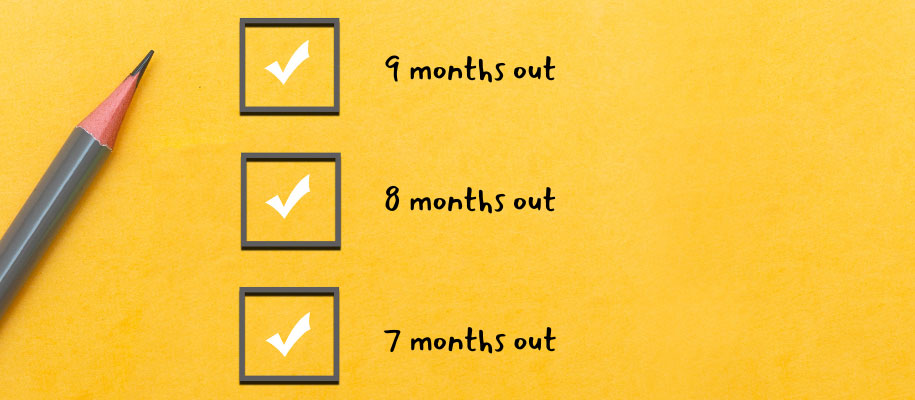Welcome to the second installment of the Graduate Admission Checklist series on what to do in the 12 months leading up to submitting your grad school application(s). This portion covers nine to seven months before applying. As previously discussed, graduate school is not something to take lightly. It involves a major investment personally, intellectually, socially, emotionally, and financially. Be sure to allow yourself enough time to do your due diligence and get all the information you want and need. And read through to the end to find your way to part three and plan your next steps!
9 months before applying
- Start planning some campus visits. It’s one thing to review a website, read printed materials, and communicate with admission office staff on the phone or via email, but it’s quite another to actually visit a campus in person. Most institutions offer a variety of campus visit programming, usually described on their website.
- Start studying for any standardized tests required as part of the application process. Depending on the program, most graduate school admission committees will require the GRE, GMAT, LSAT, or MCAT. In addition, an international applicant will most likely be required to take a test to demonstrate their level of proficiency in the English language.
- Utilize online materials to help you prepare for these tests. You’ll most likely learn about these materials from the Educational Testing Service, the Graduate Management Admission Council, the Law School Admission Council, and the Association of American Medical Colleges. These organizations have preparation materials available on their websites. Other organizations such as Barrons, Kaplan, Peterson’s, and The Princeton Review offer test preparation classes. In addition, you can go to your local bookstore and find a host of printed materials and study guides.
Pro tip: If you can afford to visit an institution more than once, make your first visit unannounced. This will help you get a feel for what the institution is really like. How you’re treated as a stranger can be very revealing. However, if you don’t have the time and/or funds to do more than one visit, you may want to wait to go until you have started the application process. In addition, you may not have the financial resources to make a campus visit at all. If so, be sure to take the virtual campus tour that is offered on most admission websites.
Related: Campus Visits: Not Just for Undergrads!
8 months before applying
- Now it's time to do additional research on your options. One area to look into is the type of press your prospective grad schools receive. There are a few ways to find this out: one is to go to the website and look for a link that might read “(institution name) in the news” or “press coverage of (institution name).” Or just use a search engine and look for press coverage. Conducting this type of search will yield more news clips than would be found on an institution’s website, as institutional websites tend to accentuate only positive media coverage.
- Read the school’s institutional and student-run newspapers. In some cases, you may have to ask for access to these, and in other cases, you can view them freely on the website. This allows you to review both external (press) and internal (institutional/student) perspectives (faculty, research, etc.), which you won’t find in admission or other promotional information.
- Look for rankings of institutions offering the graduate program you're seeking. Various organizations provide annual or biannual rankings that can be useful to you. However, remember: rankings and reputation are two different things. Organizations that do rankings may try to provide reliable information, but those actually doing the data gathering, analysis, and dissemination of the rankings have biases of their own. Oftentimes they have never stepped foot on campus. Also, rankings provide a source of revenue for the organizations participating in them. One ranking differs from the next. And by the time you enroll in graduate school, the ranking of your options will most likely have changed. Be careful about how much you allow a ranking to influence your final decision about where to apply to grad school.
7 months before applying
- Contact current students at the institutions on your list. If you know someone who's attending, contact them and ask some questions. If not, ask the admission staff if they can put you in touch with a current student or two. Many admission offices have student volunteers who are willing to talk with prospective students. If you can ask the same questions for each of your options, you'll have more information to include on your research spreadsheet.
- At this point, do a second evaluation of your options, considering what you have discovered from external and internal press, rankings, and conversations with students. Remember, you aren't ready to make your shortlist yet. You can, however, change your spreadsheet evaluations at any time. Something you learn from the press or rankings about an option you already eliminated from your list may cause you to place that option back on.
Related: Essential Grad School Search and Application Timeline
The grad school admission process is no joke. There are a lot of moving parts, a lot of research to do, a lot of requirements, and a fair amount of stress involved. But if you keep yourself organized and on top of the process by breaking it down into these easy-to-follow monthly tasks, it will be a lot easier and more effective in the long run. Keep moving forward with your planning with months 6–4 for the third installment of this four-part series.
Ready for your next steps? Keep planning for grad school applications with the 6–4-month installment of the 12-month checklist, or check out the author at his website GradSchoolRoadMap.com.








